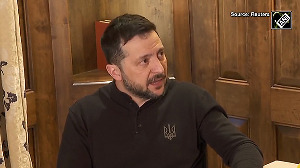Tributes are flowing in for the way that the Indian government organised Tech Mahindra's $565m rescue of Satyam, the country's fourth largest software company. The rescue came this week, just four months after Satyam crashed with the exposure of India's biggest ever corporate scam - perpetrated by the Hyderabad-based Raju family that founded, and nearly ruined, the business.
Friends in Britain have said to me that they doubt whether some western governments would be so adept at staging such a quick and efficient rescue. "We believe in capitalism -- we'd have let it crash," said a London-based journalist. That is partly true, though the British and US governments are both showing themselves willing to pump money into banks to maintain financial stability, and into auto companies to save jobs.
But what the Indian government has pumped in is far more effective than money, and the result shows how well the country can manage crises when top people do not allow themselves to be diverted by bureaucracy or vested interests.
It began with a decision by Manmohan Singh, the prime minister, that Satyam was too important to India to be allowed to fail, and that its rescue should not be delayed by official inquiries into India's biggest corporate fraud. That was followed by the recruitment of a new board of directors with real clout - including Deepak Parekh, India's most dependable top banker, Tarun Das, who presides over the Confederation of Indian Industry, and Kiran Karnik, former head of the software trade body NASSCOM.
The Company Law Board then approved significant waivers that enabled the new directors to auction Satyam without having to file restated accounts (they are still not available because of the Rajus' fraud), without holding what would have been a highly disruptive general shareholders' meeting - and with the introduction of a vetting procedure that rated bidders on their track records.
This vetting procedure was objected to by B.K.Modi, the publicity conscious head of his family's telecom-based Spice group, who lost interest in bidding for Satyam after the Company Law Board unsurprisingly rejected his appeal.
That left three viable bidders who were willing to risk Satyam's unclear finances and possible law suits - Larsen & Toubro, one of India's top engineering groups, and W.L.Ross, a New York private equity investor, as well as Tech Mahindra, which is part of the Mumbai-based Mahindra & Mahindra autos-to-infrastructure group and includes BT of the UK as a 31per cent shareholder.
So is the Satyam rescue an example of what could be done again in India and elsewhere, or was it a one-off?
It looks like a one-off because Satyam became a very special case.
All the activity, from Manmohan Singh's intervention downwards, was triggered by fear of the damage that its collapse could have done to the software and outsourcing technology industry, which has played a crucial role in building international recognition of India's economic success over the past decade or so.
It was seen as a potential disaster to allow one of the biggest companies in this sector, with top international customers such as GE, Cisco, Nestle, and Telstra, to fail because of the sort of endemic corporate corruption for which India's older industries are famous. That is why the prime minister and others moved so fast and firmly - though of course the potential loss of 45,000-50,000 jobs was also important, especially with a general election approaching.
But it need not be a one-off. It might not often be possible to tap top people like Parekh and Das, but Satyam's example does surely show the benefit of trying to re-launch (not just save) businesses that are full of talent but have been brought down by bad management.
The secret is to change the top management. That has been done by bringing in Tech Mahindra as both a new owner and manager (it's also been done by US president Barack Obama with GM).
Anand Mahindra, who runs his family group, has taken what a competitor described to me as "a punt". Satyam's broad-based international software skills will sit well alongside Tech Mahindra's telecom software expertise, and Mahindra reckons it has the top management need to produce a successful merger.
The big question now is whether the investigating authorities will pursue the fraud with the same energy that has been used to save the company - or will the Rajus' political and bureaucratic friends help to slow down the case, fudge evidence, and whittle away the charges?
If this happens, India's international reputation should surely suffer more than if Satyam had never been saved.
John Elliott was the FT's first South Asia Correspondent (1983-88) and now writes from India - see Riding the Elephant blog
Copyright: The Financial Times Limited 2009







 © 2025
© 2025